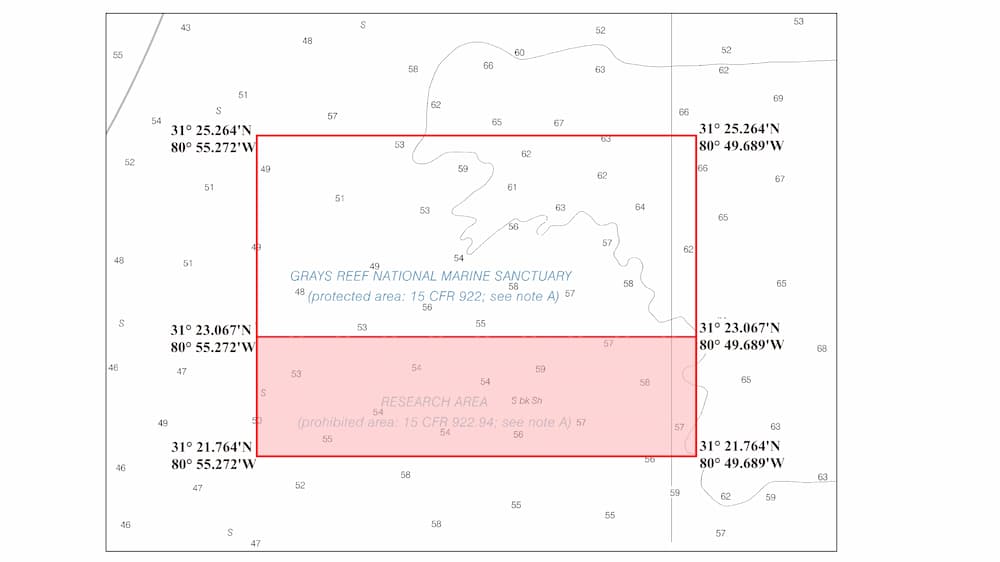FAQs
Frequently asked questions about Gray's Reef National Marine Sanctuary.
Are you allowed to fish at Gray's Reef?
Yes, Gray's Reef is a popular spot off the Georgia coast for recreational fishing. Rod and reel and handline fishing are allowed. Fishing and diving are prohibited in the southern third of the sanctuary (the research area) but vessels are allowed to travel across the area as long as they have their gear stowed properly and they don't stop. Anchoring—except during an emergency— and spearfishing are prohibited within the sanctuary. For more information, visit the Fishing page.
What fish can I catch at Gray's Reef?
Sport fishing occurs year-round but at different levels of intensity. Fishing for pelagic species such as king mackerel is one of the most popular activities; bottom fishing for snappers and groupers is also a popular summer pastime. Black sea bass and flounder are also commonly caught in the sanctuary. For more information, visit the Fishing webpage.
What are the fishing regulations in Gray's Reef?
Gray's Reef has specific fishing regulations. Only rod and reel and handline are allowable fishing gear at Gray's Reef. Spearfishing is not allowed. Except during an emergency, boats are not allowed to anchor in Gray's Reef. See the Regulations webpage for details.
In addition to sanctuary regulations, anglers should be aware of and follow all regional federal fisheries regulations, which can be found at the South Atlantic Fishery Management Council regulations web page.
What is the Research Area?
Established in 2011, the Research Area is located in the southern third of the sanctuary, an area roughly eight-square-miles. The area is relatively free of human activity that allows scientists to design and implement habitat studies where critical variables can be controlled over long periods of time. The research area is a place to study potential impacts from various activities on the sanctuary's natural resources, as well as a place to monitor and study impacts of climate change, and natural events such as hurricanes and droughts. For more information, visit the Research Area webpage.

Are you allowed to dive at Gray's Reef?
Yes. Gray's Reef is one of the most popular spots off the Georgia coast for recreational diving. The average sanctuary depth is 65 feet deep. Diving is allowed in the northern two thirds of the sanctuary, an area roughly 14 square miles. Fishing and diving are prohibited in the southern third of the sanctuary (the research area) but vessels are allowed to travel across the area as long as they have their gear stowed properly and they don't stop. Additionally, anchoring—except and spearfishing during an emergency—are prohibited within the sanctuary. For more information, visit the Diving page [link to 3.2]. For more information on regulations visit the Sanctuary Regulations webpage.
How can I visit Gray's Reef?
The sanctuary is only accessible by boat. Some independent operators run fishing trips and dive trips to the sanctuary. The Gray's Reef Ocean Discovery Center in downtown Savannah is a free space to explore the wonders of Gray's Reef National Marine Sanctuary on land.
Before your visit, explore our virtual dives and explore more information on Fishing and Diving. NOAA does not operate public tours of the sanctuary.
How can I arrange a presentation on Gray's Reef?
Gray's Reef National Marine Sanctuary offers ocean science awareness and stewardship presentations for public seminars, meetings and conferences. Complete this form to request a presentation about Gray's Reef. For more information, visit the Gray's Reef education webpage.
What is a National Marine Sanctuary and why is Gray's Reef a National Marine Sanctuary?
A national marine sanctuary is a type of marine protected area recognized by the Department of Commerce and the National Oceanic and Atmospheric Administration (NOAA) as containing a special habitat or other special resource. National marine sanctuaries are managed by the Office of National Marine Sanctuaries under the National Marine Sanctuaries Act. In 2014, a new Sanctuary Nomination Process was implemented, leading to a community-driven process for deciding which special underwater places should be considered for sanctuary designation. For more information on national marine sanctuaries, visit the National Marine Sanctuaries System webpage.
Gray's Reef was designated in 1981 in acknowledgement of the ecological importance of its live-bottom habitat; it is one of the largest near-shore, live-bottom reefs of the southeastern United States. For information, visit the Gray's Reef history webpage.

